|
MONTEZUMA CASTLE
Montezuma Castle Archeology - Part 2: Textiles |

|
TEXTILES
(Nos. 1, 2, 3, 4, 5, 6, 7, 8, 9, 10, 11, 12, 13, 14, 15, 16, 17, 18, 19, 21, 33, 34, 35, 36, 37, 39, 46, 53, 54, 55)
About half of the 61 specimens, 31 in all, in the Montezuma Castle series are classified in this paper as true textiles.
MATERIALS
They are woven from cotton and two varieties of yucca.12 Cotton is found in 27 of the 31 textiles; 23 of these have no other material combined with them. Yucca and cotton together are used in the other 4 pieces. Three of these (Nos. 53, 11 and 17) have yucca wefts and warps and some rag wefts of cotton woven in. No. 12 has yucca string warps and cotton wefts. Yucca is the sole material used in 4 specimens (5, 39, 16, 46).
12. Eight textiles, all told, employ yucca. Of this number, six are Yucca baccata (11, 12, 16, 39, 46, 53) and two are Yucca elata (17 and 5).
COLORS
Of the 31 textiles, 10 show color,13 either rubbed on the surface after weaving or applied as a dye. Only cotton fabric is so decorated. Red, black and yellow are the colors used. Red, in several shades, is the most common, appearing as the only color on 6 of the 10 textiles. It is rubbed on in two cases (Nos. 1 and 53), and used as a dye in four cases (Nos. 9, 11, 17 and 19). Red-dyed strands, as well as black-dyed strands are found in No. 56. Nos. 18 and 33 have black-dyed cotton wefts. No. 12 has some black and some yellow-dyed cotton wefts.14
13. Nos. 1, 9, 11, 12, 17, 18, 19. 33, 53, 56.14. Cf. Haury, 1934, pp. 99 and 102, and Hough, 1914, pp. 82-83.
In this series there is no evidence that designs were painted on cloth. In 6 of the 10 specimens which show color, it covers the whole, or nearly the whole, surface of the piece. In the remaining 4 textiles, colored threads are used simply to emphasize the design produced by the weaving technique; that is, the floated weft pieces (Nos. 18 and 33) have black wefts to contrast with the white warps and to bring the geometric patterns produced by weft-floating into sharp relief. The diamonds originating through the twill technique (No. 56) are emphasized by the use of black and red strands. In No. 12 the color follows the lines of the slit weave. (For dye sources see Introduction, page 3.)
SIZE
The pieces are, with one exception, small fragments. The largest fragment (No. 55) measures 24 inches (61 cm.) by 11-3/8 inches (28.9 cm.). There is one bag (No. 18) woven as a narrow cloth, 25 inches (63 cm.) long by 5-3/4 inches (14.6 cm.) wide.

|
|
Yucca elata, magnified 600 dias. Specimen No. 17 (top, left) Yucca macrocarpa, magnified 600 dias. Specimen No. 63 (middle, left) Agave parryi, magnified 600 dias. Specimen No. 5 (bottom, left) Yucca mohavensis, magnified 200 dias. Specimen No. 43 (top, right) Yucca baccata, magnified 600 dias. Specimen No. 38 (middle, right) Dasylirion wheeleri, magnified 200 dias. Specimen No. 44 (bottom, right) Plate 1. Photomicrographs. |
TECHNIQUES
All the textiles could have been woven on an upright, Pueblo-type loom, as has been determined by actual reproduction of their techniques on a model loom in the laboratory.
There are six weave techniques: plain weave, weft-warp openwork, gauze, weft-float, slit-tapestry, and diamond twill.
1. Plain weave. Thirteen of the 31 textiles are plain weave with no variations. (Nos. 1, 2, 3, 6, 7, 8, 9, 10, 14, 15, 19, 21, 55.) They are all of cotton. In these pieces it is sometimes impossible to state definitely which threads are warps and which are wefts. In cases where one element is much finer than the other, one might postulate the finer to be the warp, with coarser wefts woven in. This distinction checks with Spier's statement regarding Zuni weaving:15
" ... although both yarns are said to be from the same ball, the warp appears to be somewhat thinner and somewhat more tightly twisted than the weft. This may be due to slightly greater tension on the warp.
15. Spier, 1924, pp. 68-69.
See also McGregor:16
"Weaving yarn may be again divided into two classes; the more compact generally being the warp threads; the less well twisted, and consequently of greater diameter, being the fill, or weft threads."
16. McGregor, 1931, p. 3.
Again, in cases where one element is in a much better state of preservation than the other, one might say the former is the more tightly twisted warp, and the latter the loose weft, which disintegrated sooner. In the detailed descriptions which follow, the element having the finest stitch count may automatically be considered as the warp, unless otherwise indicated.
In this series the finest weave (No. 21) shows a stitch count of 32 warps and 28 wefts per inch (14 and 12 per cm.). The coarsest (No. 2) shows 19 warps and 18 wefts per inch (8 and 7 per cm.). The average stitch count for either element is approximately 24 per inch (10 per cm.).
Three of the 13 plain woven fabrics are colored, all with red. The red is a dye in two cases (Nos. 9 and 19), and rubbed on in one case (No. 1).
1a. Plain weave, paired wefts. The four yucca fiber17 textiles (Nos. 5, 39, 16, and 46) show the use of paired strands as wefts. The number of paired wefts to the inch varies from 7 to 11 (3 to 5 per cm.), three of the textiles having 11 pairs. The average number of warps to the inch is 10 (5 per cm.). These coarse fiber textiles, then, are a much looser weave than the cotton pieces. (See pp. 12-18.)
17. Our analysis of materials used in No. 16 allowed for yucca, apocynum and cotton. Jones found it to be primarily of yucca fibers, with some admixture of cotton, and no apocynum. We have used Whitford as final evidence.
1b. Plain weave, paired and rag wefts. Three fabrics (Nos. 11, 17, and 53) have warps and paired wefts of yucca, and also rag wefts. The latter are rolled-up strips of finely woven cotton, or bundles of cotton string. In all three pieces these strips show red color, particularly on the part that is rolled inside. The occurrence of red on the inside of the rag wefts indicates that this color was rubbed onto the cotton fabric on one side only, and that this side was rolled in; or that it was rubbed on both sides or applied as a dye, but has worn off the outside. (Nos. 11 and 17 probably are dyed, whereas No. 53 has the color rubbed on.) Where enough warp and weft remain in the strips to measure, we find a stitch count of about 24 to 28 threads to the inch (around 11 to 13 per cm.).
The strips were probably torn from worn-out cotton cloths and added to the coarse fabric as decoration. They appear throughout the fabrics at irregular intervals. (See pp. 22-25.)
1c. Plain weave, single and rag wefts. Specimens Nos. 4 and 54 are a regular plain weave of cotton, with strips of cotton cloth or bundles of cotton string woven in at intervals as wefts. (See pp. 25-26.)
2. Weft-wrap open work. There are four specimens (Nos. 34, 35, 36, and 37) which are decorated with geometric designs of openwork, produced by wrapping certain wefts around warps, according to a definite plan. These pieces are all of natural-color cotton, and have a fine stitch count of from 26 to 35 stitches to the inch (12 to 16 per cm.). Nos. 36 and 37 are probably sections of one large piece. (See pp. 27-32.)
3. Gauze Weave. Nos. 36 and 37, as well as having weft-warp decoration, have a few lines of gauze weave. In this weave variation, wefts are omitted at regular intervals, leaving rows of openwork. Within these rows adjacent warps are crossed. Such rows occur at intervals of three to five wefts. (See pp. 28-31.)
No. 13 has wefts missing at intervals, although the warps are not crossed. It is so noticeable as to suggest that wefts were pulled out purposely after weaving, or were left out during weaving. (See p. 32.) All these pieces are of finely-wove, uncolored cotton.
4. Weft-float. Two of the pieces (Nos. 18 and 33) are woven by a weft-float technique. In both cases the wefts are of black-dyed cotton and the warps of natural white cotton. A regular over-one under-one weaving of the wefts through the warps would produce a black-and-white checkerwork. In order to make a design, certain wefts are allowed to "float" across several warps at a time, according to a definite plan. The only difference between these two textiles is that in No. 18 the wefts always appear paired, while in No. 33 they are single-strand. (See pp. 33-36.) No similar articles are described in the literature on prehistoric textiles.
5. Diamond twill. Another weave type shown in this series is the diamond twill (No. 56). This piece is woven from very fine cotton. The inner diamonds are divided on their long axis in two parts, one red and one black. The red and black threads are dyed cotton—the red reacting to the test for iron. Red and black threads are introduced into the weave by knotting them onto the white weft, and weaving with them as long as desired. The wefts pass over-three under-three. The loom rig for this technique calls for five heddles and a shed rod. There is no mention of such a set-up in the literature on Southwestern weaving, the diamond twills described requiring only three heddles and a shed rod. (See pp. 37-40.)
6. Slit-tapestry weave. There is one slit-tapestry textile (No. 12) in the Montezuma Castle series. In this technique a weft, instead of being laid in the entire width of the piece, is woven back and forth over three warps five times, then brought over a warp to right or left, and the process repeated. Hence, a number of slits are produced throughout the textile. These slits divide wefts of different colors. (See pp. 40-41.)
BORDER TECHNIQUES
Seven of the textiles have small sections of borders. The most common border technique used is similar to that found on the sides of Navaho blankets. A weft hooks between two units, each of which is composed of three loosely twisted strings, and re-enters the weave again. The units are crossed on each other once; and the next weft hooks between them again. In brief, the units are twined along the edge of the piece. Three pieces have this border type (Nos. 7, 18, and 33; pp. 14, 33, 36.)
A second technique (No. 14; p. 16) shows four strings twisted together. The wefts hook through these, over a different one each time. There is the addition of a string twisted over the four border elements to hold them more tightly together.
No. 4 (p. 25) has an edge cord consisting of five twisted threads. The warps loop over this cord.
The last two techniques classified here as "borders" may in reality be attempts to keep a cut or torn edge from raveling. There is one edge (No. 21; p. 18) showing four strands twisted over the last three weft strands of the regular plain weave. Lastly there is a piece (No. 8, p. 15) showing 1/4-inch of the weave rolled up at the edge and bound by a string.
COMPARATIVE DATA
Plain weave is the most common technique found in prehistoric sites. Plain weave with paired or rag wefts, however, has a somewhat more limited distribution. According to present information pieces come from Tonto National Monument, Canyon Creek and the Lower Verde. Hence it appears to be a feature of central Arizona weaving rather than an Anasazi trait.
Weft-wrap openwork and gauze are widely distributed, appearing at: Keet Seel, Nitsie Canyon, Canyons de Chelly and del Muerto, Wupatki, the Verde Salt Mines, Canyon Creek, Bear Creek Cave, the Upper Gila, Solomonsville, Snaketown, Casa Grande National Monument, and Ventana Cave on the Papago Reservation. These techniques are found in higher frequencies in central and southern sites, and appear in the south in early horizons. Fragments woven by a technique similar to weft-wrap are mentioned by Haury18 as coming from the Sacred Cenote at Chichen Itza, Yucatan. These techniques may have originated in the Southwest with the Hohokam, and spread north as trade goods to the Anasazi in Pueblo III times.
18. Haury, 1934, p. 95.
Weft-float is not reported from any other sites.
Slit-tapestry weave is widely distributed in Anasazi sites from Basketmaker times on, and is found outside that area in the following places: Sycamore Canyon in the Verde drainage, the "Red Rock country south of Flagstaff,"19 Kinnikinnick (southeast of Flagstaff), Wupatki National Monument, Tonto National Monument, and Ventana Cave. It is probably a typical northern technique as contrasted to weft-wrap and gauze.
19. Hough, 1914.
Twills similar to that described here are well represented in Pueblo III Anasazi collections. The technique seems to be much more characteristic of that area than of central and southern Arizona, although there are twill fragments from Los Guanacos in the Salt River Valley of southern Arizona, Tonto National Monument, Kinishba, and Wupatki National Monument.
The pages following are devoted to descriptions, photographs, and drawings of the 31 textiles. Table IV, page 94, in the appendix, coordinates data on these specimens, listing each by number and telling what material was used in it, its weave, color, border (if present), and comparative literature relative to it.
Specimen 1. Textile
Maximum length: 22-1/2"; 57.2 cm.
Maximum width: 13"; 33.1 cm.
Threads per inch in length: 25; 10 per cm.
Threads per inch in width: 21; 9 per cm.
Material: Cotton
Decoration: There are evidences that the piece was colored by rubbing on red paint. Most of it is gone at present.
Weave: Plain; edges frayed, with one possible border. Widely spaced darning for reinforcement near one end. (See photograph.)

|
| Plate 2. Plain weave, Specimen No. 1 |
Specimen 2. Textile
Maximum length: 12-3/8"; 31.5 cm.
Maximum width: 3-1/2"; 9 cm.
Threads per inch in length: 18; 7 per cm.
Threads per inch in width: 19; 8 per cm.
Material: Cotton. Dark gray due to weathering.
Decoration: Lacking.
Weave: Plain. Rather loosely woven. Frayed edges.

|
| Plate 3. Plain weave, Speciment Nos. 2, 3 |
Specimen 3. Textile
Maximum length: 4"; 10.2 cm.
Maximum width: 3-5/16"; 8.5 cm.
Threads per inch in length: 19; 8 per cm.
Threads per inch in width: 21; 9 per cm.
Material: Cotton.
Decoration: Lacking.
Weave: Plain. Loosely woven. Frayed edges.
Specimen 6. Textile
Maximum length: 32"; 81.4 cm.
Maximum width: 2-3/8"; 6.1 cm.
Threads per inch in length: 23; 10 per cm.
Threads per inch in width: 22; 10 per cm.
Material: Cotton.
Decoration: Lacking.
Weave: Plain, with a frayed edge.

|
| Plate 4. Plain weave, Specimen No. 6 |

|
| Fig. 1. A weft hooks between two units, each of which is composed of three loosely-twisted strings, and reenters the weave again. The units are crossed on each other once before the next weft hooks through them. Specimen 7. |
Specimen 7. Textile
Maximum length: 8-1/2"; 21.6 cm.
Maximum width: 5/8"; 1.6 cm.
Threads per inch in length: 17; 7 per cm.
Threads per inch in width: 17 per 1/2-inch (probably 34 per inch); 14 per cm.
Material: Cotton.
Decoration: Lacking.
Weave: Plain. There are borders on both sides of the textile, running the length of the piece. (Cf. Hough, p. 77, Fig. 160; BAEB 6520, p. 116, Fig. 44.)
20. To save space BAEB 65 is used hereafter to refer to Kidder and Guernsey, 1919.

|
| Plate 5. Plain weave, Specimens Nos. 7, 8 |
Specimen 8. Textile
Maximum length: 7"; 17.9 cm.
Maximum width: 1"; 2.6 cm.
Threads per inch in length: 20; 9 per cm.
Threads per inch in width: 22; 10 per cm.
Material: Cotton.
Decoration: Lacking.
Weave: Plain, with one border.
One-quarter inch of the weave is rolled up at the edge and bound by a cotton string composed of two tightly-twisted strands of cotton. (BAEB 65, p. 116: "When cloth was cut across for any reason, it was kept from raveling by rolling up the edge and sewing it over and over with stout thread.")

|
| Figure 2 |
Specimen 9. Textile
Maximum length: 16-3/4;"; 24.6 cm.
Maximum width: 3-3/16"; 8.1 cm.
Threads per inch in length: 24; 9 per cm.
Threads per inch in width: 25; 11 per cm.
Material: Cotton.
Decoration: Orange dye, M&P 12-A-1221, evidently applied before the cotton was woven. External, granular, mineral pigment.
21. All color references are to: Maerz, A., and Paul, M. Rea: A Dictionary of color. New York, McGraw-Hill Book Company, 1930.
Weave: Plain and rather loose. Frayed edges.

|
| Plate 6. Plain weave, Specimens Nos. 9, 10 |
Specimen 10. Textile
Maximum length: 8-1/2"; 21.6 cm.
Maximum width: 3-3/4;"; 9.5 cm.
Threads per inch in length: 28; 13 per cm.
Threads per inch in width: 24; 10 per cm.
Material: Cotton. Light yellow tan, M&P 11-I-6. Color apparently due to scorching. (Jones noted the presence of one hair from a small mammal.)
Decoration: Lacking.
Weave: Plain.
Specimen 14. Textile
Maximum length: 9-1/4"; 23.5 cm.
Maximum width: 6-1/2"; 16.5 cm.
Threads per inch in length: 23; 9 per cm.
Threads per inch in width: 22; 8 per cm.
Material: Cotton.
Decoration: Cotton has a mottled yellow color, probably due to scorching.
Weave: Plain, with one border. (Cf. Haury, p. 84, fig. 16, e; and Specimen 7, p. 14.)

|
| Plate 7. Plain weave, Specimen No. 14 |

|
| Fig. 3. There are four border elements twisted together. The warps are hooked through them, apparently over a different one each time. There is the addition of a string consisting of two strands of cotton tightly twisted (a), which serves to bind the border elements more tightly together. No. 14. |
Specimen 15. Textile
Maximum length: 4"; 10.2 cm.
Maximum width: 4"; 10.2 cm.
Threads per inch in length: 27; 12 per cm.
Threads per inch in width: 27; 12 per cm.
Material: Cotton.
Decoration: Lacking.
Weave: Plain, with frayed edges. Very tight.

|
| Plate 8. Plain weave, Specimen No. 15 |
Specimen 19. Textile
Maximum length: 6-1/2"; 16.8 cm.
Maximum width: 1/2"; 1.25 cm.
Average threads per inch in length: 37; 16 per cm.
Average threads per inch in width: 18 per half inch (probably 36 per inch); 14 per cm. Fine texture.
Material: Cotton.
Decoration: Granular, external, mineral dye, red-orange in color, M&P 5-H-11.
Weave: Plain.

|
| Plate 9. Plain weave, Specimens Nos. 19, 21 |
Specimen 21. Textile
Maximum length: 8-1/2"; 21 cm.
Maximum width: 3-1/8"; 8 cm.
Average threads per inch in length: 32; 15 per cm.
Average threads per inch in width: 28; 12 per cm. Fine texture.
Material: Cotton. Brownish-gray, M&P 5-A-9. (Jones' analysis notes "some bit of extraneous material"; and ours notes one unidentified plant fiber.)
Weave: Plain. One border. (Cf. PMP, VIII, 2, p. 65.) Four strands twisted over the last three weft strands of the regular plain weave.

|
| Figure 4 |
Specimen 55. Textile
Maximum length: 24"; 61 cm.
Maximum width: 11-3/8"; 28.9 cm.
Threads per inch in length: 23; 10 per cm.
Threads per inch in width: 30; 12 per cm.
Material: White cotton.
Weave: Plain weave. One little extra piece of cloth is knotted onto the main section at one end. This specimen is the largest in the collection.

|
| Plate 10. Plain weave, Specimen No. 55 |
Specimen 5. Textile
Maximum length: 6-3/4"; 17.3 cm.
Maximum width: 4-1/2"; 11.3 cm.
Threads per inch in length: 9; 4 per cm.
Threads per inch in width: 22 (11 pairs) ; 10 (5 pairs) per cm. Each strand is more tightly twisted than the warp fiber.
Material: Yucca elata. Tawny yellow in color, though not dyed. (Jones' analysis notes "a few cotton fibers, one hair of a small mammal and other extraneous matter.")
Decoration: Lacking.
Weave: A regular plain weave, except that the wefts are composed of two strands which are treated exactly as one. (Cf. Haury, p. 102; and Fig. 21, a, p. 101.)

|
| Plate 11. Paired wefts, single warps, Specimen No. 5 |

|
| Figure 5 |
Specimen 16. Textile
Maximum length: 5-1/2"; 14 cm.
Maximum width: 5"; 12.7 cm.
Threads per inch in length: 22 (11 pairs); 10 (5 pairs) per cm.
Threads per inch in width: 12; 6 per cm.
Material: Yucca baccata. Dark yellow-gray, due to weathering. (Jones analysis and ours note some cotton fibers.)
Decoration: Lacking.
Weave: Plain, with wefts composed of two strands each. (Cf. Specimens Nos. 5, above, and 39, p. 21.)
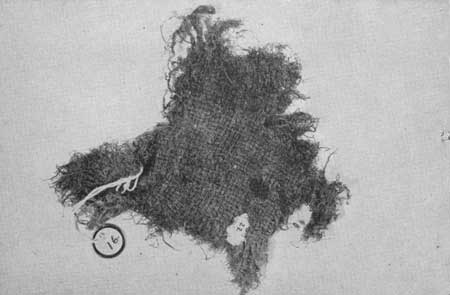
|
| Plate 12. Paired wefts, single warps, Specimen No. 16 |
Specimen 39. Textile
Maximum length: 11-5/8"; 29.5 cm.
Maximum width: 3-1/4"; 8.3 cm.
Threads per inch in length: 11; 5 per cm.
Threads per inch in width: 22 (11 pairs); 8 (4 pairs) per cm.
Material: Yucca baccata.
Decoration: Lacking.
Weave: Regular plain weave with wefts always paired. (Cf. Specimen 5, p. 19.)

|
| Plate 13. Paired wefts, single warps, Specimen No. 39 |
Specimen 46. Textile
Maximum length: 8-1/2"; 21.6 cm.
Maximum width: 2-1/4"; 5.8 cm.
Threads per inch in length: 14 (7 pairs); 6 (3 pairs) per cm.
Threads per inch in width: 8; 4 per cm.
Material: Yucca baccata.
Decoration: Lacking.
Weave: Plain weave, with wefts appearing in pairs. (Cf. Specimen 5, p. 19.) Border. (Cf. Specimen No. 7, p. 14: Hough, p. 77, Fig. 160.)
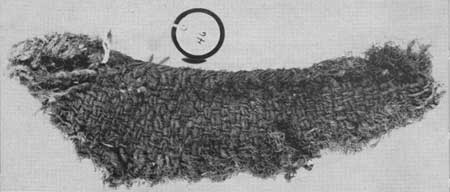
|
| Plate 14. Paired wefts, single warps, Specimen No. 46 |

|
| Figure 6. |
Specimen 11. Textile
Maximum length: 11"; 28 cm.
Maximum width: 4-3/8"; 11.1 cm.
Threads per inch in length: 9; 4 per cm.
Threads per inch in width: 10 (5 pairs) per half-inch; 10 (5 pairs) per cm. See analysis under Weave.
Material: Cotton in the finely-woven strips. (Our analysis notes that the red may have one fiber of apocynum in it.) Coarse fiber in the two-weft one-warp weave is Yucca baccata. (Jones' analysis notes one hair of a small mammal.) Mottled medium dark yellow gray. (Cf. Haury, p. 102; Hough, p. 81.)
Decoration: The red threads used in the weft (and sometimes warp) of the finely woven cotton strips seem to have been dyed before use with an external, granular, mineral dye.
Weave: Basically a plain weave is used. (Cf. Haury, p. 102, and Fig. 21, C, p. 101; and Specimens Nos. 4, p. 25; 17, p. 23, 39, p. 21, and 53, p. 23.) Pairs of strands, and rolled strips of finely-woven cotton cloth are used as wefts. In most of the cloth strips the weft has disintegrated, leaving only a bundle of warp threads. The construction of the weft elements, starting from the top of the photograph, is:
1. Bundle of 20 strands. 3/16"; .5 cm.
2. Plain weave; one weft unit (two strands). 1/8"; .3 cm.
3. Bundle of 14 strands. 1/8"; .3 cm.
4. Plain weave; 5 weft units (10 strands). 1/2"; 1.2 cm.
5. Bundle of 12 strands. 3/16"; .4 cm.
6. Plain weave; four weft units (eight strands). 3/8"; 1 cm.
7. Bundle of 15 strands. 3/16"; .4 cm.
8. Plain weave; four weft units (eight strands). 3/8"; 1 cm.
9. Bundle of 30 strands, red in color. 1/4"; .7 cm.
10. Plain weave; two weft units (four strands). 3/16"; .4 cm. Widens to four weft units (eight strands). 3/8"; 1 cm.
11. Bundle of two narrow woven strips rolled together. Where the weft remains one finds: Strip No. 1: Nine gray warp threads. 1/4"; .6 cm. Eight strands of weft in 1/4, .6 cm. Four wefts are gray, and four are red.
Strip No. 2: All gray strands. Twelve warp strands in 1/4", .6 cm. strip. Eight wefts per 1/4", .6 cm. Both strips are of an over-under plain weave.
12. Plain weave, and frayed edge.
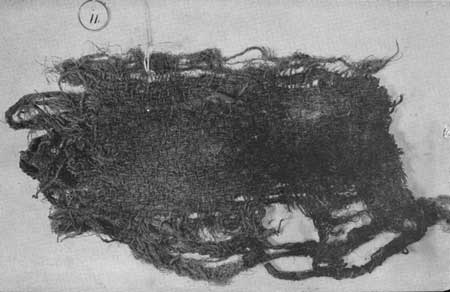
|
| Plate 15. Paired wefts, rag wefts, Specimen No. 11 |

|
| Figure 7 |
Specimen 17. Textile
Maximum length: 10-3/4"; 27.4 cm.
Maximum width: 4"; 10.2 cm.
Threads per inch in length: 8; 4 per cm.
Threads per inch in width: See analysis under Weave.
Material: Cotton in the finely-woven strips. Coarse fiber in the plain weave is Yucca elata.
Decoration: Some of the fibers of the finely-woven cotton strips are dyed red. Granular, external, mineral dye. Whole piece is rusty brown.
Weave: Plain weave, with paired strands, and rolled strips of finely-woven cotton cloth used as wefts. (Cf. Haury, p. 102; Hough, p. 82.) (See drawing.)
Two strips of cotton cloth, each ca. 3/16" (.4 cm.) wide. The 3/4;" (1.9 cm.) between the two strips contains 10 yucca fiber wefts (5 pairs). In the cotton strips there are 14 warps per cm. (3/8"), and 14 wefts per cm.
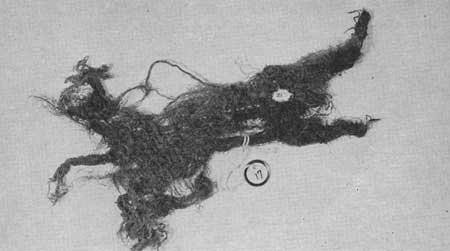
|
| Plate 16. Paired wefts, rag wefts, Specimen No. 17 |

|
| Figure 8 |
Specimen 53. Textile. (PS No. 165)
Maximum length: 10"; 25.5 cm.
Maximum width: 3-3/4"; 9.5 cm.
Threads per inch in length: 5; .2 per cm. (warps).
Threads per inch in width: 20, 9 per cm. (wefts).
Material: Cotton in the rag wefts: Yucca baccata in coarse wefts and warps.
Decoration: Red color is rubbed on to the rag wefts, appearing generally on the side which is folded in. (It is probable that both sides originally showed color, rubbed on or applied as a dye, and that the color has worn off the outer sides of the strips.)
Weave: (Cf. Haury, p. 101, Fig. 21, d; Specimen No. 11, p. 22) Plain weave. Warps are coarse one-unit strands. Wefts: Appear most regularly as coarse strands consisting of two smaller units twisted together. In some of the more ragged portions, three and four strands pass over a warp together, as though they were 1 weft element. Cotton rags are woven in irregularly as wefts. Composition: (starting at top of photograph)
1. Large rag strip. Measures when unfolded, 1-3/8"; 3.5 cm. (When folded 3/8"; 1 cm.) Stitch count, 24 per inch; 12 per cm.2. Four double-twist wefts.
3. Rag weft, 3/16"; .5 cm., when folded.
4. One double-twist weft.
5. Rag weft, 1/4"; .7 cm., when folded.
6. Five double-twist wefts.
7. Rag weft, 1/8"; .3 cm., when folded.
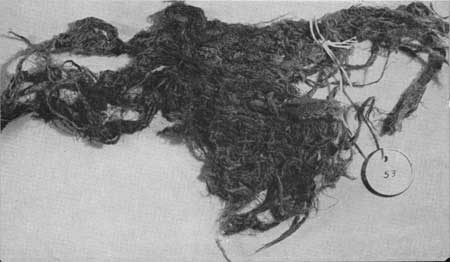
|
| Plate 17. Paired wefts, rag wefts, Specimen No. 53 |
Specimen 4. Textile
Maximum length: 5-1/2"; 13.2 cm.
Maximum width: 2-5/8"; 6.8 cm.
Threads per inch in length: 14; 6 per cm.
Threads per inch in width: See analysis of Weave.
Material: Cotton. (Jones' analysis notes two hairs of a small mammal and one of a large mammal.)
Decoration: Some evidence that yellow was rubbed on, but this is so problematical that it is not considered elsewhere in the paper. Woven strips or twisted cotton threads are introduced to vary the weave.
Weave: Plain weave, with weft elements of woven strips or twisted cotton threads. (Cf. Haury, p. 102; Hough, p. 82; Specimens Nos. 11, p. 22, 17, p. 23, 39, p. 21, and 53, p. 23.) In general, the warp strands are much thicker and less tightly twisted than the strands which go to make up the bundle wefts. The fragment appears to be from the border of a piece. Counting down from the top, the sequence of wefts is:
1. Border: composed of five twisted threads, over which the warp is looped.
2. Plain weave; two wefts. 1/16"; .2 cm.
3. Bundle; ca. 5 strands, somewhat twisted. 1/8"; .3 cm.
4. Plain weave; three wefts. 1/8"; .3 cm.
5. Bundle; crudely woven strip. 3/16"; .5 cm.
6. Plain weave; two wefts. 1/16"; .2 cm.
7. Bundle; braided strands. ca. 3/16"; .4 cm.
8. Plain weave; two wefts. 1/16"; .2 cm.
9. Bundle; ca. 10 strands, not twisted. 1/8"; .3 cm.
10. Plain weave; two wefts. 1/16"; .2 cm.
11. Bundle; eight strands, not twisted. 1/16"; .2 cm.
12. Plain weave; five wefts. 1/4"; .7 cm.
13. Bundle; five untwisted strands. 1/16"; .2 cm.
14. Plain weave; six wefts. 3/8"; 1 cm.
15. Untwisted bundle of strands and frayed edge.
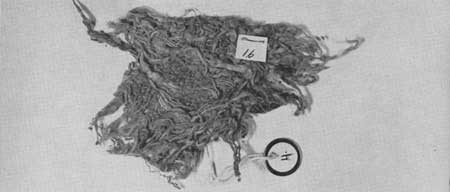
|
| Plate 18. Single wefts, rag wefts, Specimen No. 4 |

|
| Figure 9 |
Specimen 54. Textile. (PS No. 49)
Maximum length: 17-1/4"; 43.8 cm.
Maximum width: 3-1/2"; 8.9 cm.
Threads per inch in length: 13; 6 per cm. Two strands tightly twisted. (warps)
Threads per inch in width: 11 thread wefts, 4 bundle wefts per inch; 4 regular wefts, 2 bundle wefts per cm.
Material: Cotton. Decoration: The bundle wefts have a yellowish tinge. However, it does not seem to be true color rubbed on, but to be stained cotton.
Weave: Cf. Hough, p. 82, Fig. 170; Specimens Nos. 11, p. 22, and 53, p. 23.) Plain weave. At intervals of three to five wefts, a bundle weft is introduced, each measuring 1/8" (.3 cm.) in width. These bundle wefts contain from six to nine threads. They seem to have no wefts within themselves, but to be simply long ropes of cotton threads. In some places, however, there is evidence that wefts formerly existed. The assumption is that these threads have been ravelled out of a piece of woven cloth, and still retain the impressions of wefts, if not the actual threads.
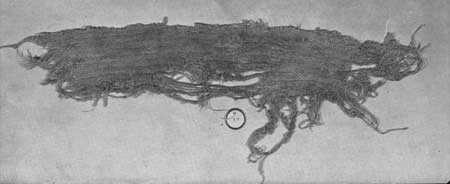
|
| Plate 19. Single wefts, rag wefts. Specimen No. 54 |

|
| Figure 10 |
Specimen 35. Textile
Maximum length: 7-5/8"; 19.5 cm.
Maximum width: 2-1/2"; 6.5 cm.
Stitch count: 27 per inch; 12 per cm.
Material: Cotton.
Decoration: Geometric design made by wrapping wefts. (See photograph).
Weave: Weft-wrap openwork. (Cf. Specimens Nos. 34, p. 31, 36 and 37, p. 28-9; Haury, p. 92; Hough, pp. 78-79.) (See drawing.)
The principle of weft-wrap is fairly simple. Assume that the warps are strung on a loom much like the Navaho-Pueblo loom of today, and that the weaving is proceeding from the bottom upward. When the weaver desires an openwork pattern, she wraps the weft most recently inserted twice over the three wefts below it. Then she weaves this weft over and under the next four warps and wraps it twice around them. From there the weft passes once under the weft below and repeats the weaving and wrapping of the four warps. Next the three wefts below are wrapped twice. After this the weft wraps once around the next warp and goes back into regular weaving. This makes openings in the fabric. The process is continued till the desired number of openings has been produced. Every fourth weft is used thus till the design is completed. There are slight variations in the manner of wrapping the weft, but the small section shown in the technical drawing (p. 28) is typical for Specimens Nos. 35, 36 and 37. The wrapping may have been done with the help of a needle.
Close observation of each piece leads to the conclusion that all wrapping is done with the wefts, the warps remaining stationary. Haury's analysis agrees with this, but Hough's drawings and descriptions of similarly decorated pieces show both warps and wefts being used as wrapping elements. If this were so, it is obvious that the piece must have been at least partially removed from the loom when wrapping commenced; or else that the fabric was woven plain and then certain warps and wefts were selected, partially extracted from the weave, and used as wrapping elements. Sections of the weft-wrap pieces were worked out in the laboratory and proved very simple to execute on a regular loom, with the help of a needle for the wrap-sections.
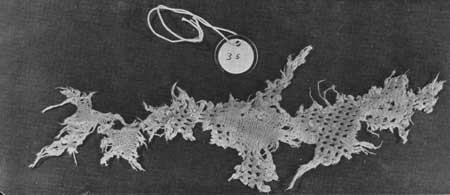
|
| Plate 20. Weft-wrap, Specimen No. 35 |

|
| Figure 11 |
Specimen 36. Textile
Maximum length: 7-1/2"; 19 cm.
Maximum width: 4-1/2"; 11.5 cm.
Stitch count, solid section: 34 per inch; 15 per cm.
Material: Cotton.
Decoration: See under Weave.
Weave: Weft-wrap openwork, as in Specimen No. 35, p. 27. Gauze weave (explanation below.
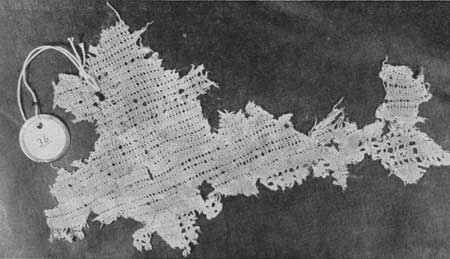
|
| Plate 21. Weft-wrap, gauze weave, Specimen No. 36 |
Specimen 37. Textile
Maximum length: 5-3/8"; 13.7 cm.
Maximum width: 5"; 12.7 cm.
Stitch count, solid section: 35 per inch, 16 per cm.
Material: Cotton.
Decorations: see under Weave.
Weave: Weft-wrap openwork, as in specimen No. 35, p. 27. Gauze weave. Specimens Nos. 36 and 37 are probably fragments of one large piece. In both of them the weft-wrap design is produced as shown in the drawing (p. 28). There are also lines of gauze weave openwork at intervals of three, sometimes five, threads, wherein one weft is omitted, and pairs of warps are crossed once over each other. They are then taken back into the regular weave by the next weft.

|
| Figure 12 |
This decoration has been produced on a regular loom, without untying the warps from the loom bars. Commence the gauze pattern when the warps controlled by the shed rod are forward, as though for insertion of the batten. Now, starting at your right, cross the first forward warp to the left and behind the first back warp. Insert the batten in the loop thus formed. Repeat this same procedure the width of the piece. The batten will then be in the position illustrated, and there will be two twists in the warps (a and b). (The shed rod controlled strings are numbered 1, the heddle rod controlled strings, 2.) Now insert the weft and remove the batten. For the next row, force the warps controlled by the shed rod forward again (as in regular weaving) and insert the weft behind them. If another row of weft is desired before the warps cross back to their original positions in the weave it is necessary to pull forward each heddle-controlled warp by hand, keeping 2 always to the right of 1, and insert the batten behind it below twist b. To bring the warps back to the original positions, pull the heddle rod forward and insert the weft above twist b. The plain checker weave can now be continued.
Haury, (pp. 95-98) describes gauze weaving, and figures a piece exactly like ours from the Verde Salt Mine. Hough (pp. 79-80) shows fragments from Bear Creek Cave, Blue River, Arizona, and tells of an example from a cave near Solomonsville, Arizona. His figure 166 (p. 80) shows gauze weave produced by an entirely different technique from the one described in this paper. He says certain warp threads were not carried the whole length of the piece, thus leaving spaces, wherein wefts were crossed in pairs, and the gauze weave pattern made. If this were so, the gauze weave could not be a loom product. It is impossible to draw conclusions concerning Hough's technical description without studying the piece he figures. However, it would seem more logical to call his warps "wefts," and his wefts "warps."
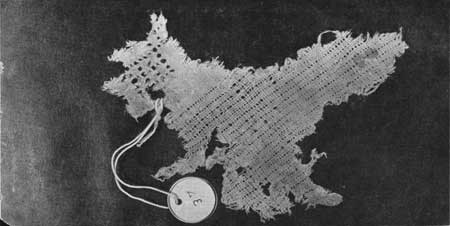
|
| Plate 22. Weft-wrap, gauze weave, Specimen No. 37 |
Specimen 34. Textile
Maximum length: 8-3/4"; 22.3 cm.
Maximum width: 5-3/4"; 14.7 cm.
Stitch count: 26 per inch; 12 per cm. The warps and wefts run diagonally to the length and width of the piece as measured. The stitch count for both is the same.
Material: Cotton.
Decoration: Geometric design made by wrapping with wefts. (See photograph.)
Weave: Weft-wrap openwork. (Cf. Specimens Nos. 35, p. 27, 36 and 37, p. 29, Haury, p. 92; Hough, pp. 78-79.) See drawing.
The wrapping in No. 34 presents some differences from that just described. As will be concluded from the technical drawing (p. 28), photographs and the explanation (p. 30), the wrappings in Nos 36, 37 and 35 will always be parallel to the warps or wefts. In No. 34, however, the wrapping can be either at an angle or parallel to the warps and wefts. The weft chosen, instead of first enclosing only the three wefts below it, wraps around a woven section consisting of the three wefts below it and the four warps just ahead, or behind, the point where the wrapping commenced. It will be seen in the drawing below that the irregular manipulation of wefts A and D occurs simply as a means of enlarging the holes. Irregular manipulation of B and C before and after use as wrapping elements serves the same purpose, and also enables them to leave and reenter the plain weave at right angles to the warps.
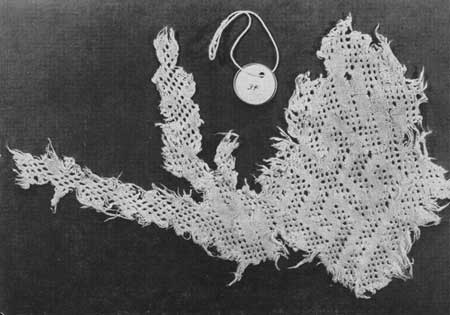
|
| Plate 23. Weft-wrap, Specimen No. 34. |

|
| Figure 13 |
Specimen 13. Textile
Maximum length: 11"; 28 cm.
Maximum width: 2-3/8"; 6.1 cm.
Threads per inch in length: 9 per half-inch; 7 per cm. Threads per inch in width: 25; 11 per cm.
Material: Cotton.
Decoration: See analysis under Weave.
Weave: Gauze? The weft is missing at regular intervals of one-half inch (1.3 cm.). The open slits thus left measure ca. 1/4" (.6 cm.). Nine such slits can be distinguished. In some of them one can see two warp threads twisted together. The suggestion is that the slits are intentional, and for purpose of forming a design. (Cf. Hough, p. 79, Fig. 165; Haury, p. 95, and Fig. 20, a, p. 96; and Specimens Nos. 36 and 37, pp. 28-29.) A bit of coarse two-ply cotton cord is attached at one end of a slit place. One white ply and on orange-yellow. Purpose undetermined.
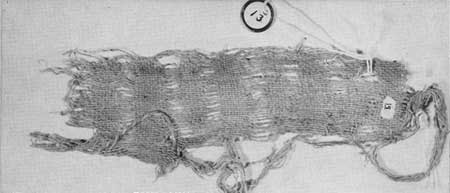
|
| Plate 24. Gauze weave, Specimen No. 13 |
Specimen 18. Textile
Maximum length: 25"; 63 cm.
Maximum width: 5-3/4"; 14.6 cm.
Threads per inch in length: 40; 20 per cm.
Threads per inch in width: 28; 12 per cm.
Material: Cotton. Black and white weft threads and white warp.
Decoration: Geometric design in black and white, made by skipping, or floating, the weft threads. (See photograph.) The black is internal, vegetal dye.
Weave: Weft-float. Wefts are skipped or floated to produce the design. The weft elements always appear in pairs. (Cf. Specimen No. 33.) There is a border at either end of the piece. Border A is one-fourth inch (.6 cm.) wide, and contains six weft threads. Border B is one-eighth inch (.3 cm.) wide, and contains three weft threads. These borders are plain weave and are finished off with the same technique used in specimen No. 7, p. 14). The side borders are handled exactly the same. The piece was sewed up the sides with a regular running stitch, so that it became a bag. A possible reconstruction of the loom set-up for the piece shows similarities with the Pueblo loom of today. It is impossible to say whether the warp threads were strung as figure eights. The warps were controlled by the fingers, rather than by heddle rods.
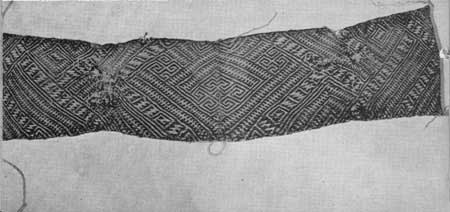
|
| Plate 25. Weft float, Specimen No. 18 |
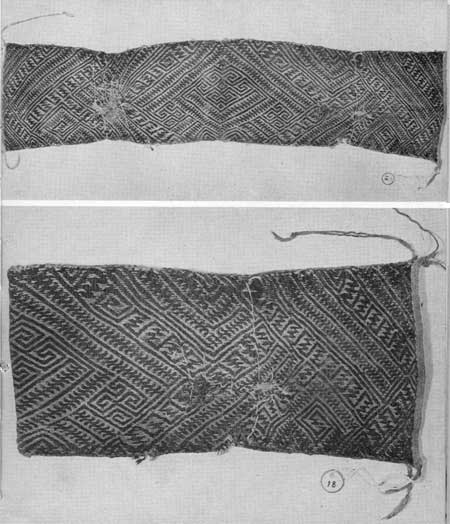
|
| Plate 26. Weft float, Specimen No. 18 |

|
| Figure 14. Possible reconstruction of loom set-up for Specimen No. 18 |

|
| Figure 15 |
Specimen 33. Textile. (PS No. 124)
Maximum length: 7-1/2"; 19 cm.
Maximum width: 4"; 10.2 cm.
Threads per inch in length: 25; 10 per cm. (wefts)
Threads per inch in width: 32; 15 per cm. (warps)
Material: White cotton warps. Black cotton wefts.
Decoration: Geometric design made by floating the white warp threads. The black is internal, vegetal dye.
Weave: Weft-float. (Cf. Specimen No. 18, p. 33.) In this piece the weft strands always appear as single units, whereas in No. 18 they are always in pairs. One border. (Cf. Specimen No. 7, p. 14.)
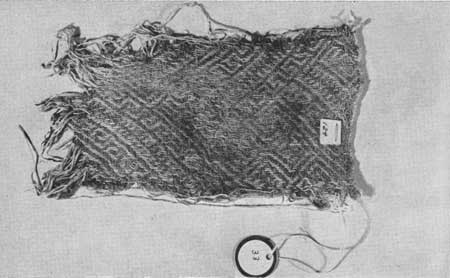
|
| Plate 27. Weft float, Specimen No. 33. |
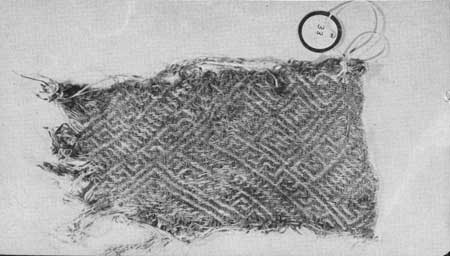
|
| Plate 28. Weft float, Specimen No. 33 (obverse view). |
Specimen 56. Textile
Maximum length: 6-7/8"; 17.5 cm.
Maximum width: 5-5/16"; 13.5 cm.
Threads per inch in length and width: 22; 10 per cm.
Material: Cotton.
Decoration: Red dyed cotton; external dye which reacts to the test for iron. Black dyed cotton: the black dye is internal vegetal. Pattern of concentric diamonds. The inner diamonds are divided on their long axis in two parts, one red and one black. Each diamond has sides 1" (2.5 cm.) long.
Weave: Diamond twill with interlocking wefts.
The heddle arrangement for this technique calls for five heddles and a shed rod. The wefts pass over-three, under-three warps. Red and black threads are tied into the weave when desired for the design. There is no mention of such a set-up in the literature on Southwestern weaving, the diamond twills described requiring only three heddles and a shed rod. Amsden figures the fragment here described and says in speaking of the technique (page 57):
"I find no evidence that the diamond twill was used in mechanical weaving by the prehistoric Pueblos, although they used the diagonal twill, as was said. They knew the diamond twill as a finger method, certainly, as plate 35, C proves. (This) . . . is a cotton cloth fragment which appears to he loom-woven; close scrutiny shows, however, that the weft threads forming the diamond do not extend across the full width of the warps as they would if woven in the loom. Inferentially, the diamond twill originated in a hand technique and was adapted to the loom by a weaver skillful enough to work out the complicated heddle arrangement. (Unless it should prove another European trait introduced by Spaniard or American.)"
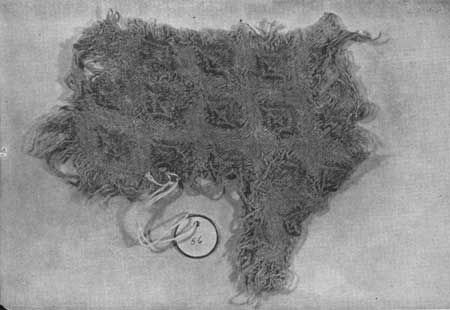
|
| Plate 29. Diamond twill. Specimen No. 56 |

|
| Fig. 16. Numbers up the side of the diamond indicate heddle numbers as shown on page 39. SR indicates "shed rod," as shown on the same page. Numbers at the bottom of the diamond refer to warp threads as listed on the same page. |
The fact that the wefts are not continuous across the piece is not a valid objection to a mechanical weaving of the piece, as laboratory research shows. Assume the weaver wishes to insert the black wefts as shown in the drawing. He is about to place a weft in the shed opened by the shed rod, passing the thread from left to right. He draws it only to the point where he desires a black thread to appear. He then inserts the black, drawing it from left to right, as far as desired. At this point a white thread is tied to it and carried across the remainder of the row. The next shed is opened with heddle 1. The two white weft sections pass from right to left, and the black fills the space between them, passing from left to right. That the use of five heddles and a shed rod was not unknown to the prehistoric Pueblo weavers is further demonstrated by a herring-bone twill specimen from Wupatki. The wefts pass over and under three warps, which would require five heddles and a shed rod.

|
|
Heddle one pulls forward: 2, 3, 4-8, 9, 10-14, 15, 16-20, 21-22-
drop one -24, 25, 26-30, 31, 32-36, 37, 38-42, 43, 44-48, 49, 50- drop
51, 52 and repeat the above. Heddle two pulls forward: 1, 2, 3-7, 8, 9-13, 14, 15-19, 20, 21- drop three -25, 26, 27-31, 32, 33-37, 38, 39-43, 44, 45-49, 50, 51- drop 52 and repeat the above. Heddle three pulls forward: 1, 2-6, 7, 8-12, 13, 15-18, 19, 20- drop five - 26, 27, 28-32, 33, 34-38, 39, 40-44, 45, 46-50, 51, 52- repeat from above. Heddle four pulls forward: 1-5, 6, 7-11, 12, 13-17, 18, 19-23, 27, 28, 29-33, 34, 35-39, 40, 41-45, 46, 47-51, 52- repeat the above. Heddle five pulls forward: -4, 5, 6-10, 11, 12-16, 17, 18-22, 23, 24-28, 29, 30-34, 35, 36-40, 41, 42-46, 47, 48-52- repeat the above. Shed rod takes: -3, 4, 5-9, 10, 11-15, 16, 17-21, 22, 23, 24, 25-29, 30 31-35, 36, 37-41, 42, 43-47, 48, 49-drop, 50, 51, 52 and repeat the above. To make the diamond pull the heddles and shed rod in the following order: 1, 2, 3, 4, 5, shed rod;Figure 17. Chart showing warp stringing for diamond twill, No. 56 |
Specimen 12. Textile
Maximum length: 7"; 17.9 cm.
Maximum width: 3-3/4"; 9.6 cm.
Threads per inch in length: 29; 14 per cm. (wefts)
Threads per inch in width: 11; 5 per cm. (warps)
Material: Cotton wefts; warps of Yucca baccata. (Jones notes: "Gray weft includes extraneous material and a hair of a small mammal." Our analysis notes: "Gray weft is primarily cotton, but contains animal hair, probably from Lutrea sonora, the Arizona Otter, which has been collected at Montezuma Well.")
Decoration: Geometric design in gray (faded black), yellow and brown. The design is strictly governed by the technique. The yellow is granular, external, mineral dye; while the black is internal, vegetal dye.
Weave: Slit-tapestry. (Cf. Steen, pp. 458-459; Hough, p. 81; Guernsey, p. 97-98.)
A weft, instead of being laid in the entire width of the piece, is woven hack and forth over three warps five times, then brought over a warp to right or left, and the process repeated. Hence, a number of slits are produced throughout the textile. This technique was easily reproduced on a model loom without the use of heddle rods. The desired warps were chosen by hand and held forward with the batten while the wefts were woven over them. The colors are separated into geometric designs by the slits produced in weaving. Wefts are beaten so closely together that warps are completely covered.
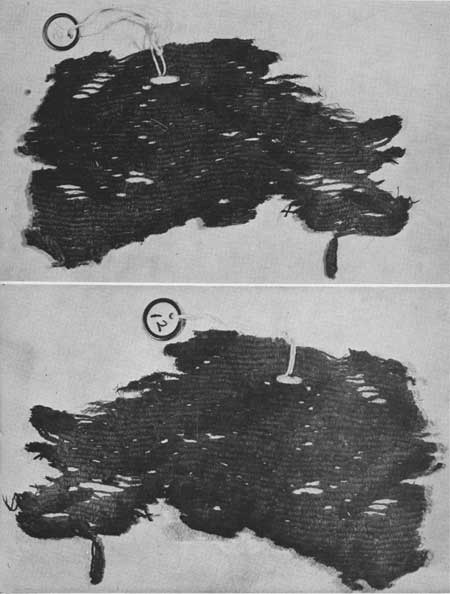
|
| Plate 30. Slit-tapestry weave, Specimen No. 12 |

|
| Figure 18 |
| <<< Previous | <<< Contents>>> | Next >>> |
wnpa/tech/3-2/sec1.htm
Last Updated: 04-Mar-2008
Western National Parks Association